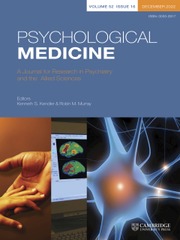Review Article
Effects of psychosis-associated genetic markers on brain volumetry: a systematic review of replicated findings and an independent validation
-
- Published online by Cambridge University Press:
- 28 September 2022, pp. 3753-3768
-
- Article
-
- You have access
- Open access
- HTML
- Export citation
Understanding the development of bipolar disorder and borderline personality disorder in young people: a meta-review of systematic reviews
-
- Published online by Cambridge University Press:
- 30 September 2022, pp. 3769-3782
-
- Article
-
- You have access
- Open access
- HTML
- Export citation
Original Article
Weight gain as a risk factor for progressive neurochemical abnormalities in first episode mania patients: a longitudinal magnetic resonance spectroscopy study
-
- Published online by Cambridge University Press:
- 12 March 2021, pp. 3783-3791
-
- Article
- Export citation
Associations between individual antipsychotics and the risk of arrests and convictions of violent and other crime: a nationwide within-individual study of 74 925 persons
-
- Published online by Cambridge University Press:
- 11 March 2021, pp. 3792-3800
-
- Article
-
- You have access
- Open access
- HTML
- Export citation
Intrauterine testosterone exposure and depression risk in opposite-sex and same-sex twins, a Danish register study
-
- Published online by Cambridge University Press:
- 16 March 2021, pp. 3801-3806
-
- Article
- Export citation
Childhood adversity, pubertal timing and self-harm: a longitudinal cohort study
-
- Published online by Cambridge University Press:
- 08 March 2021, pp. 3807-3815
-
- Article
-
- You have access
- Open access
- HTML
- Export citation
Apolipoprotein E e4 allele status and later-life depression in the Lothian Birth Cohort 1936
-
- Published online by Cambridge University Press:
- 02 March 2021, pp. 3816-3824
-
- Article
-
- You have access
- Open access
- HTML
- Export citation
How does the COVID-19 pandemic impact on population mental health? A network analysis of COVID influences on depression, anxiety and traumatic stress in the UK population
-
- Published online by Cambridge University Press:
- 16 March 2021, pp. 3825-3833
-
- Article
-
- You have access
- Open access
- HTML
- Export citation
Latent cause inference during extinction learning in trauma-exposed individuals with and without PTSD
-
- Published online by Cambridge University Press:
- 08 March 2021, pp. 3834-3845
-
- Article
- Export citation
The role of characterisation in everyday voice engagement and AVATAR therapy dialogue
-
- Published online by Cambridge University Press:
- 08 April 2021, pp. 3846-3853
-
- Article
-
- You have access
- Open access
- HTML
- Export citation
Self-reported and mother-rated personality traits at age 16 are associated with cognitive function measured concurrently and 30 years later
-
- Published online by Cambridge University Press:
- 12 March 2021, pp. 3854-3864
-
- Article
- Export citation
Efficacy of attention bias modification training for depressed adults: a randomized clinical trial
-
- Published online by Cambridge University Press:
- 26 March 2021, pp. 3865-3873
-
- Article
-
- You have access
- Open access
- HTML
- Export citation
The independent and combined effects of cannabis use and systemic inflammation during the early stages of psychosis: exploring the two-hit hypothesis
-
- Published online by Cambridge University Press:
- 19 March 2021, pp. 3874-3884
-
- Article
- Export citation
Cognitive heterogeneity in first-episode psychosis and its relationship with premorbid developmental adjustment
-
- Published online by Cambridge University Press:
- 12 March 2021, pp. 3885-3894
-
- Article
- Export citation
Unexpected effects of expressive writing on post-disaster distress in the Hurricane Harvey Study: a randomized controlled trial in perinatal women
-
- Published online by Cambridge University Press:
- 12 March 2021, pp. 3895-3903
-
- Article
- Export citation
Columbia-Suicide Severity Rating Scale Screen Version: initial screening for suicide risk in a psychiatric emergency department
-
- Published online by Cambridge University Press:
- 26 March 2021, pp. 3904-3912
-
- Article
-
- You have access
- Open access
- HTML
- Export citation
Using multivariate endophenotypes to identify psychophysiological mechanisms associated with polygenic scores for substance use, schizophrenia, and education attainment
-
- Published online by Cambridge University Press:
- 18 March 2021, pp. 3913-3923
-
- Article
-
- You have access
- Open access
- HTML
- Export citation
The economic cost of bulimia nervosa and binge eating disorder: a population-based study
-
- Published online by Cambridge University Press:
- 17 May 2021, pp. 3924-3938
-
- Article
- Export citation
Experimentally imposed circadian misalignment alters the neural response to monetary rewards and response inhibition in healthy adolescents
-
- Published online by Cambridge University Press:
- 17 March 2021, pp. 3939-3947
-
- Article
- Export citation
A comparison of ‘pruning’ during multi-step planning in depressed and healthy individuals
-
- Published online by Cambridge University Press:
- 12 March 2021, pp. 3948-3956
-
- Article
-
- You have access
- Open access
- HTML
- Export citation



